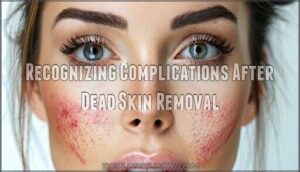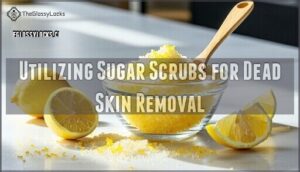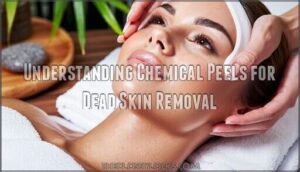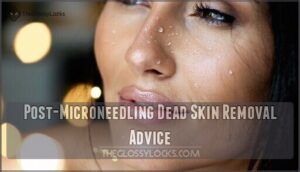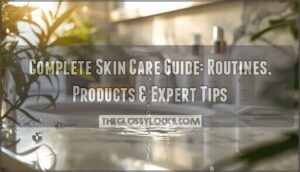This site is supported by our readers. We may earn a commission, at no cost to you, if you purchase through links.

Your skin needs this time to heal properly, like letting a scab form naturally. Once ready, use lukewarm water and a soft washcloth to gently wipe away loose flakes.
Mild enzyme cleansers work well too, breaking down dead cells without scrubbing. Never pick at peeling skin or use harsh scrubs—think of your healing skin as delicate tissue paper.
Pat dry and apply a gentle moisturizer afterward. The key is patience and gentle touch to avoid irritation or scarring. Proper timing and technique make all the difference in your recovery success.
Table Of Contents
- Key Takeaways
- How to Remove Dead Skin After Microneedling?
- Importance of Dead Skin Removal
- Consequences of Not Removing Dead Skin
- Recognizing Complications After Dead Skin Removal
- Exfoliation for Dead Skin Removal
- Facial Cleansing Brush for Dead Skin Removal
- Using Salt Scrubs for Dead Skin Removal
- Utilizing Sugar Scrubs for Dead Skin Removal
- Understanding Chemical Peels for Dead Skin Removal
- Post-Microneedling Dead Skin Removal Advice
- Frequently Asked Questions (FAQs)
- Should you moisturize after microneedling?
- Does microneedling cause blemishes?
- What happens after microneedling?
- Does microneedling really work?
- Can microneedling cause breakouts?
- How long after microneedling should I wash my face?
- Can I exfoliate dead skin after microneedling?
- What happens if I peel my skin after microneedling?
- How long does skin look bad after microneedling?
- How do you repair skin after microneedling?
- Conclusion
Key Takeaways
- Wait 3-5 days before removing dead skin – Your skin needs this healing time to recover properly from microneedling, so do not rush the process or you will risk scarring and infection.
- Use gentle methods only – Stick to lukewarm water with soft washcloths or mild enzyme cleansers to remove loose flakes, and never pick at peeling skin or use harsh scrubs.
- Pat dry and moisturize immediately – After gently removing dead skin, pat your face dry and apply a fragrance-free moisturizer to support continued healing and prevent irritation.
- Watch for warning signs – Stop immediately if you notice excessive redness beyond 5 days, pus, unusual discharge, or spreading inflammation, as these indicate potential complications requiring professional attention.
How to Remove Dead Skin After Microneedling?
After microneedling, your skin will naturally start peeling as part of the healing process.
This postmicroneedling peeling typically begins 3-5 days post-treatment.
The peeling timeline varies, but you’ll notice microneedling shedding for about a week.
For safe dead skin removal, choose gentle alternatives over harsh scrubs.
Exfoliation after microneedling should focus on gentle alternatives like enzyme-based products or mild chemical exfoliants.
Remember that some individuals experience temporary sun sensitivity following the procedure.
Wait at least 3-7 days before attempting any removal to prevent scarring concerns and infection prevention.
Proper microneedling aftercare includes using lukewarm water, patting skin dry, and applying fragrance-free moisturizers.
If you’re unsure about timing or technique, consider professional removal to avoid complications.
Importance of Dead Skin Removal
After microneedling, your skin becomes a canvas ready for transformation, but dead skin cells can block this process.
Dead skin removal is essential for maintaining the enhanced results you’re seeking. Without proper exfoliation after microneedling, those micro-channels can clog, limiting product absorption and skin renewal.
Regular removal promotes improved texture while preventing breakouts that occur when pores become congested. Think of it as clearing the pathway for your skin’s natural healing process.
Gentle postmicroneedling peeling helps microneedling shedding happen effectively, maximizing your investment in healthier, more radiant skin. This process is vital because environmental factors damage the skin.
Consequences of Not Removing Dead Skin
When you skip dead skin removal after microneedling, you’re setting yourself up for trouble.
Bacterial Growth thrives in accumulated cells, leading to skin irritation and potential infections. Impeded Healing occurs as your natural recovery process slows down considerably.
You’ll notice Prolonged Redness and Uneven Texture that won’t budge. Product Absorption drops dramatically, making your expensive serums practically useless.
This creates a frustrating cycle where your postmicroneedling skin healing stalls, leaving you with disappointing results instead of the glowing complexion you expected.
This is because the procedure can cause temporary increased UV sensitivity.
Recognizing Complications After Dead Skin Removal
Understanding what’s normal versus concerning after removing dead skin can save you from serious complications.
Your skin’s been through trauma, so watch for these infection signs that need immediate attention:
- Excessive redness lasting beyond five days with increasing warmth or pain
- Skin infections showing pus, unusual discharge, or spreading inflammation
- Postinflammatory hyperpigmentation creating dark patches that weren’t there before
Delayed healing, increased sensitivity, and persistent skin irritation aren’t just inconvenient—they’re red flags.
Microneedling stimulates the skin’s collagen production and natural healing.
When scarring risks become apparent, don’t wait.
Exfoliation for Dead Skin Removal
Peeling away dead skin after microneedling doesn’t have to feel overwhelming. You’ll find three main skin exfoliation methods that work effectively for gentle exfoliation and dead skin removal.
Physical Exfoliation uses brushes or gloves with cleansers to manually remove buildup. Chemical Exfoliation employs AHAs or BHAs to dissolve cells gradually. Enzyme Exfoliation harnesses natural fruit enzymes for sensitive skin types.
Consider these exfoliation benefits for ideal results:
- Improved skin texture and tone
- Enhanced product absorption
- Accelerated cellular renewal
Choose your method based on skin sensitivity and exfoliation timing preferences. Regular exfoliation can also prevent hairs growing inward, a common issue after skin treatments.
Facial Cleansing Brush for Dead Skin Removal
Moving beyond chemical exfoliants, facial cleansing brushes offer another gentle approach for dead skin removal after microneedling. These tools provide controlled gentle exfoliation while supporting your postmicroneedling aftercare routine.
Brush types matter substantially for your healing skin. Sonic brushes with soft bristle material work best, delivering up to 99.5% dirt removal without harsh scrubbing.
Wait at least 72 hours post-treatment before introducing any cleansing brush to avoid disrupting your skin’s natural recovery process. Pressure control is your friend here. Use light, circular motions with lukewarm water and a mild cleanser designed for sensitive skin.
Your skin sensitivity will guide the intensity – if it feels uncomfortable, you’re pressing too hard. Brush sanitation prevents bacterial buildup that could trigger breakouts. Rinse thoroughly after each use and allow air-drying.
Many prefer wipes infused with aloe and glycerin for their soothing and hydrating properties. This skin exfoliation method enhances product absorption by 61% while respecting your healing skin barrier.
Using Salt Scrubs for Dead Skin Removal
While facial cleansing brushes offer gentle exfoliation, salt scrubs provide more intensive dead skin removal after microneedling. These mineral-rich exfoliants contain coarse crystals that mechanically slough away stubborn skin cells, revealing smoother skin beneath.
Salt Scrub Benefits include deep pore cleansing and improved circulation. However, timing matters substantially for postmicroneedling aftercare. Wait 5-7 days before attempting any exfoliation to allow proper healing.
Scrub Application Tips: Mix sea salt with carrier oil like jojoba or coconut oil to reduce abrasiveness. Apply using light, circular motions, avoiding the delicate eye area. Limit use to once weekly during recovery. Sourcing organic ingredients ensures purity for your scrub.
Salt Scrub Dangers include potential skin tears if used too aggressively or too soon. Homemade Salt Scrubs offer ingredient control, while commercial versions provide convenience.
After rinsing, apply hydrating serums containing hyaluronic acid or peptides. If your skin shows irritation, consider Salt Scrub Alternatives like gentle enzyme treatments for safer skin peeling management.
Utilizing Sugar Scrubs for Dead Skin Removal
After waiting 5-7 days post-microneedling, sugar scrubs offer gentle dead skin removal through their natural exfoliating properties. These sweet alternatives provide effective skin shedding support while delivering moisturizing benefits. A great option is a lemon sugar scrub, known for its brightening effects.
Sugar Scrub Benefits include:
- Gentle mechanical exfoliation with rounded sugar crystals
- Natural glycolic acid content promotes skin cell turnover
- Softer abrasive action compared to harsh alternatives
DIY Sugar Scrubs mix granulated sugar with carrier oils like jojoba. Follow proper Scrub Application Tips: use light circular motions for 30 seconds maximum, then rinse with lukewarm water. Post-Scrub Skincare requires immediate hydration to support continued healing.
Understanding Chemical Peels for Dead Skin Removal
After microneedling, chemical peels offer controlled dead skin removal through targeted chemical exfoliation.
These treatments use specific peel ingredients like alpha hydroxy acids and beta hydroxy acids to dissolve damaged cells effectively.
Consider these professional peels options:
- Light glycolic peels – gentle surface renewal with minimal downtime
- Medium TCA peels – deeper penetration for stubborn dead skin patches
- Salicylic acid peels – ideal for oily, acne-prone skin types
- Enzyme peels – natural fruit acids for sensitive post-microneedling skin.
These peels often incorporate beneficial antioxidants to protect the skin.
Understanding peel strengths prevents complications, while proper post-peel care minimizes potential peel side-effects.
Post-Microneedling Dead Skin Removal Advice
After your microneedling treatment, following proper posttreatment care becomes your roadmap to healthy skin recovery.
The healing process occurs in stages, and understanding each phase helps you make informed decisions about dead skin removal. Redness and swelling are common side effects, resembling a sunburn.
| Care Stage | Key Actions |
|---|---|
| Days 1-3 | Gentle cleansing with mild, pH-balanced products |
| Days 4-7 | Begin light hydration methods using hyaluronic acid |
| Week 2 | Introduce gentle exfoliation for dead skin removal |
| Week 3-4 | Resume normal skincare with careful product ingredients |
| Ongoing | Daily sunscreen importance can’t be overstated |
Your skin’s like a construction site during the healing stages – it’s rebuilding from the ground up. Stick to fragrance-free cleansers and avoid harsh scrubbing. Consistency in your routine trumps aggressive treatments every time.
Remember, patience isn’t just a virtue here; it’s your skin’s best friend during microneedling recovery.
Frequently Asked Questions (FAQs)
Should you moisturize after microneedling?
Ironically, while microneedling strips away old skin, you’ll need to baby your face afterward.
Yes, you should definitely moisturize after microneedling.
Use gentle, hydrating products with hyaluronic acid to support healing and prevent excessive peeling.
Does microneedling cause blemishes?
Yes, you might experience temporary blemishes after microneedling.
The procedure can trigger breakouts through increased oil production, bacteria introduction, or clogged pores from dead skin cells, but these typically resolve within days.
What happens after microneedling?
Studies show 85% experience noticeable skin peeling within 3-5 days.
After microneedling, you’ll notice redness and swelling initially.
Your skin then enters healing mode, shedding dead cells while producing fresh collagen for smoother, brighter results.
Does microneedling really work?
Research shows it’s effective for reducing acne scars, fine lines, and improving skin texture.
You’ll see results after multiple sessions, typically 3-6 treatments spaced weeks apart.
Results aren’t instant but develop gradually.
Can microneedling cause breakouts?
Like opening Pandora’s box, microneedling can trigger breakouts you didn’t expect.
You’re basically creating tiny wounds that bacteria love to infiltrate.
Your disrupted skin barrier and excess oil production create perfect conditions for unwanted blemishes to emerge, which can be considered as opening a kind of Pandora’s box.
How long after microneedling should I wash my face?
Wait 4-6 hours after microneedling before gently washing your face with lukewarm water and a mild, fragrance-free cleanser.
Pat dry softly—don’t rub.
Your skin needs time to start healing properly.
Can I exfoliate dead skin after microneedling?
Feeling impatient with that post-treatment peeling?
You can gently exfoliate after microneedling, but timing’s vital.
Wait 3-7 days, then use mild chemical exfoliants like gentle AHAs.
Skip harsh scrubs—they’ll irritate your healing skin.
What happens if I peel my skin after microneedling?
Peeling your skin after microneedling can disrupt healing, cause scarring, and lead to infection.
You’ll risk hyperpigmentation, delayed recovery, and uneven texture.
Let dead skin shed naturally to avoid compromising your results, as this will help prevent infection.
How long does skin look bad after microneedling?
Your skin typically looks red and feels tight for 2-4 days after microneedling.
Peeling starts around day 3-5 and lasts 3-7 days.
Most people see normal skin appearance return within one week.
How do you repair skin after microneedling?
Apply gentle, pH-balanced cleansers and lukewarm water daily.
Use hyaluronic acid serums for hydration, then lightweight moisturizers with ceramides.
Protect with broad-spectrum SPF 30+ sunscreen.
Avoid harsh products until your skin’s fully healed.
Conclusion
Following these gentle methods for how to remove dead skin after microneedling guarantees your skin’s renewal process stays on track.
Your face has been through quite the transformation, and treating it with care prevents setbacks.
Remember to wait those vital 3-5 days before starting any removal techniques, and use lukewarm water, soft cloths, and mild cleansers only.
Patience truly pays off here—rushing the process can undo all your microneedling benefits and leave you with unwanted complications.
- https://qureskincare.com/pages/microinfusion
- https://www.healthline.com/health/beauty-skin-care/what-is-retinol
- https://my.clevelandclinic.org/health/articles/22915-hyaluronic-acid
- https://ellemesmedspa.com/microneedling/how-many-sessions-of-microneedling-you-should-expect/
- https://www.bloomberg.com/profile/company/1480836D:US



